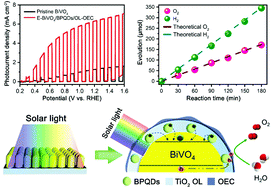A two-photon tandem black phosphorus quantum dot-sensitized BiVO4 photoanode for solar water splitting†
Abstract
The photoelectrochemical (PEC) water splitting efficiency is profoundly restricted by the limited light harvesting, rapid charge recombination, and sluggish water oxidation kinetics, in which the construction of a photoelectrode requires a strategic approach to overcome such intrinsic hurdles. Herein, we demonstrate novel black phosphorus quantum dots (BPQDs) with significant light absorbability up to the near-infrared region (NIR) to sensitize the etched BiVO4 photoanode (E-BiVO4) for a two-photon absorption tandem photoanode. A subsequent TiO2 overlayer (OL) significantly improves the stability of the E-BiVO4/BPQDs and eliminates the surface trap state to enhance charge separation. Finally, an oxygen evolution catalyst (OEC), NiOOH, loaded on E-BiVO4/BPQDs/OL further improves the water oxidation kinetics. The rationally designed E-BiVO4/BPQDs/OL-OEC with multiple components, each with definite functions, achieves a photocurrent density of 6.2 mA cm−2 at 1.23 V vs. reversible hydrogen electrode (RHE) under AM 1.5 illumination, offering a high-end standard approach for achieving efficient solar-to-fuel conversion devices by combining a photosensitizer and passivation layer.



 Please wait while we load your content...
Please wait while we load your content...